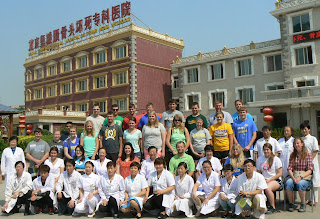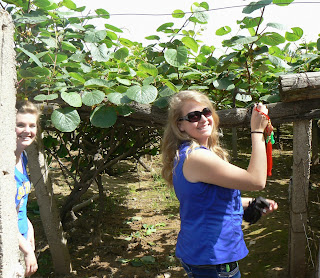Our last day in Xi'an
started off with a buffet breakfast in our hotel. After breakfast we packed our
bags and headed to the meat market. After seeing the seafood market and fruit
and vegetable market, we all expected this one to be about the same. At 4:30
a.m. every day of the week, animals start coming to market and then get
harvested including carcasses and intestines, and brought to their individual booths
for display to try and sell them. The meat in the early morning is the most
expensive because it is the freshest. As the day goes on, the meat gets cheaper
and cheaper until the meat is completely gone. If the meat did not sell, it
gets put into a freezer to sell the next day. The sellers live above where they
sell their meat in small dormitories. There was also a building full of delicacies
including: pig snouts, cured blood, which is a Jello/solid form of blood. They
also had a special spot for every animal's organs. After the meat market, we
toured the connecting fruit and vegetable markets. It is cool to see it all in
one place because then the locals can get everything they need in one area.
Walking through the veggie market, we noticed an odd shaped object. With a
closer look, we found out it was a green, Buddha shaped squash. They did this
by planting a squash seed into a molded out box of a Buddha which when it grew
it filled out all the creases making a Buddha squash. Something new at this
fish market, were that the heads of the fish were just chilling in a basket
waiting to be packaged and sold. Also, we noticed huge bags of live frogs
waiting to be sold for whatever reason, we do not know.
After the markets we
loaded the bus to head to the train station. While on our way there, our tour
guide for Xi'an, quizzed us on the culture and history of China. She handed out
small Terra-Cotta Warriors and information books about China's history as
prizes. Also, she showed us what a 1,000 year old egg is. Back in the day when
there were no refrigerators, people would wrap lime around the raw egg for 30
days and bury it before consumption. Our tour guide bought one from the veggie
market and cut it open to show us. It was gold and had a Jello texture to it.
No one had the guts to try it.
Once we got to the
train station, we said goodbye to our tour guide, Maggie, and headed to
McDonald's for a quick lunch. Not realizing how many people would be riding our
train with us, made for a hectic process. We had to get all of our luggage and
bodies onto the train all while other impatient passengers were trying to get
past us to their seats. Some of them ended up sitting in our seats but luckily
Janet was able to sort everything out for us. The train left at 1:15 p.m. and
arrived around 6 p.m. in Beijing. The train has a top speed of 218 mph. It is
pretty neat to see the country side out the windows.
After arriving in
Beijing, we met our new tour guide, Michelle, who took us to our first Hot Pot
restaurant. Each individual student had their own boiler in front of them at
the table which had broth mixed with different vegetables and seasonings. After
the broth was boiled, we were given platefuls of thinly sliced meats and
veggies which we threw into the boiler and dipped into a salty but tasty sesame
sauce. Everyone seemed to enjoy this meal as there finally a lot of beef,
mutton, and shrimp for us to fill up on.
Finally, we arrived
at our hotel in the north east part of Beijing where a lot of foreign business
people stay and do business. We are planning to go wonder the streets of
Beijing before a big day tomorrow.
-Katie
and Dakota
























































